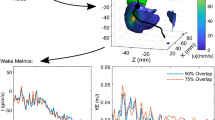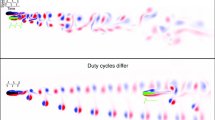Abstract
Synthetic aperture PIV (SAPIV) is used to quantitatively analyze the wake behind a giant danio (Danio aequipinnatus) swimming freely in a seeded quiescent tank. The experiment is designed with minimal constraints on animal behavior to ensure that natural swimming occurs. The fish exhibits forward swimming and turning behaviors at speeds between 0.9 and 1.5 body lengths/second. Results show clearly isolated and linked vortex rings in the wake structure, as well as the thrust jet coming off of a visual hull reconstruction of the fish body. As a benchmark for quantitative analysis of volumetric PIV data, the vortex circulation and impulse are computed using methods consistent with those applied to planar PIV data. Volumetric momentum analysis frameworks are discussed for linked and asymmetric vortex structures, laying a foundation for further volumetric studies of swimming hydrodynamics with SAPIV. Additionally, a novel weighted refocusing method is presented as an improvement to SAPIV reconstruction.














Similar content being viewed by others
References
Adhikari D, Longmire EK (2012) Visual hull method for tomographic PIV measurement of flow around moving objects. Exp Fluids 53(4):943–964
Adhikari D, Longmire E (2013) Infrared tomographic PIV and 3D motion tracking system applied to aquatic predatorprey interaction. Meas Sci Technol 24(2):024011
Anderson J (1996) Vorticity control for efficient propulsion. Ph.D. thesis, Massachusetts Institute of Technology
Barrett DS, Triantafyllou MS, Yue DKP, Ma Grosenbaugh, Wolfgang MJ (1999) Drag reduction in fish-like locomotion. J Fluid Mech 392(1):183–212
Belden JL (2011) Synthetic aperture imaging for three dimensional resolution of fluid flows. Ph.D. thesis, Massachusetts Institute of Technology
Belden J, Truscott TT, Axiak MC, Techet AH (2010) Three-dimensional synthetic aperture particle image velocimetry. Meas Sci Technol 21(12):125403
Belden J, Ravela S, Truscott TT, Techet AH (2012) Three-dimensional bubble field resolution using synthetic aperture imaging: application to a plunging jet. Exp Fluids 53(3):839–861
Borazjani I, Sotiropoulos F (2008) Numerical investigation of the hydrodynamics of carangiform swimming in the transitional and inertial flow regimes. J Exp Biol 211(10):1541–1558
Dabiri JO (2005) On the estimation of swimming and flying forces from wake measurements. J Exp Biol 208(18):3519–32
Drucker E, Lauder G (1999) Locomotor forces on a swimming fish: three-dimensional vortex wake dynamics quantified using digital particle image velocimetry. J Exp Biol 202(18):2393–2412
Elsinga G, Scarano F, Wieneke B, van Oudheusden B (2006) Tomographic particle image velocimetry. Exp Fluids 41(6):933–947
Epps BP, Techet AH (2007) Impulse generated during unsteady maneuvering of swimming fish. Exp Fluids 43(5):691–700
Epps BP, Valdivia y Alvarado P, Youcef-Toumi K, Techet AH (2009) Swimming performance of a biomimetic compliant fish-like robot. Exp Fluids 47(6):927–939
Fish F, Lauder G, Mittal R, Techet A, Triantafyllou M, Walker J, Webb P (2003) Conceptual design for the construction of a biorobotic AUV based on biological hydrodynamics. In: International symposium on unmanned untethered submersible technology, New Hampshire, USA
Flammang B, Lauder G, Troolin D, Strand T (2011a) Volumetric imaging of fish locomotion. Biol Lett 7(5):695–698
Flammang BE, Lauder GV, Troolin DR, Strand T (2011b) Volumetric imaging of shark tail hydrodynamics reveals a three-dimensional dual-ring vortex wake structure. Proc R Soc B 278(1725):3670–3678
Ghaemi S, Scarano F (2010) Multi-pass light amplification for tomographic particle image velocimetry applications. Meas Sci Technol 21(12):127002
Hunt JC, Wray A, Moin P (1988) Eddies, streams, and convergence zones in turbulent flows. Cent Turb Rep CTR 88:193–208
Im S, Jeon YJ, Sung HJ (2015) Tomo-PIV measurement of flow around an arbitrarily moving body with surface reconstruction. Exp Fluids 56(2):1–16
Jeon YJ, Sung HJ (2012) Three-dimensional PIV measurement of flow around an arbitrarily moving body. Exp Fluids 53(4):1057–1071
Kitzhofer J, Nonn T, Brücker C (2011) Generation and visualization of volumetric PIV data fields. Exp Fluids 51:1471–1492
Langley KR, Hardester E, Thomson SL, Truscott TT (2014) Three-dimensional flow measurements on flapping wings using synthetic aperture PIV. Exp Fluids 55(10):1–16
Lauder GV (2009) Swimming hydrodynamics: ten questions and the technical approaches needed to resolve them. Exp Fluids 51(1):23–35
Lauder GV, Madden PGA (2006) Learning from fish: kinematics and experimental hydrodynamics for roboticists. Int J Autom Comput 3(4):325–335
Luff J, Drouillard T, Rompage A, Linne M, Hertzberg J (1999) Experimental uncertainties associated with particle image velocimetry (PIV) based vorticity algorithms. Exp Fluids 26(1–2):36–54
McCutchen D (1977) Froude propulsive efficiency of a small fish, measured by wake visualization. In: Pedley T (ed) Scale effects in animal locomotion. Academic Press, London, pp 339–363
Müller U, Heuvel B, Stamhuis E, Videler J (1997) Fish foot prints: morphology and energetics of the wake behind a continuously swimming mullet (Chelon labrosus Risso). J Exp Biol 200(22):2893–2906
Müller U, Stamhuis E, Videler J (2000) Hydrodynamics of unsteady fish swimming and the effects of body size: comparing the flow fields of fish larvae and adults. J Exp Biol 203(2):193–206
Murphy D, Webster D, Yen J (2012) A high-speed tomographic PIV system for measuring zooplanktonic flow. Limnol Oceanogr Methods 10:1096–1112
Murphy DW, Webster DR, Yen J (2013) The hydrodynamics of hovering in antarctic krill. Limnol Oceanogr Fluids Environ 3(1):240–255
Peng J, Dabiri JO, Madden PG, Lauder GV (2007) Non-invasive measurement of instantaneous forces during aquatic locomotion: a case study of the bluegill sunfish pectoral fin. J Exp Biol 210(4):685–698
Raffel M, Willert C, Willert CE, Kompenhans S (1998) Particle image velocimetry. Springer, Berlin
Sakakibara J, Nakagawa M, Yoshida M (2004) Stereo-PIV study of flow around a maneuvering fish. Exp Fluids 36(2):282–293
Scarano F (2013) Tomographic PIV: principles and practice. Meas Sci Technol 24(1):012001
Scharfman B, Hart D, Techet A (2013) Light field imaging of turbulent liquid sheet breakup in air. In: 10th international symposium on particle image velocimetry, Delft, The Netherlands
Siddiqui MHK (2007) Velocity measurements around a freely swimming fish using PIV. Meas Sci Technol 18(1):96–105
Spedding G, Rayner J, Pennycuick C (1984) Momentum and energy in the wake of a pigeon (Columba livia) in slow flight. J Exp Biol 111(1):81–102
Stamhuis E, Videler J, van Duren L, Müller U (2002) Applying digital particle image velocimetry to animal-generated flows: traps, hurdles and cures in mapping steady and unsteady flows in Re regimes between \(10^-2\) and \(10^5\). Exp Fluids 33(6):801–813
Stamhuis E, Videler J (1995) Quantitative flow analysis around aquatic animals using laser sheet particle image velocimetry. J Exp Biol 198(Pt 2):283–294
Strawn RC, Kenwright DN, Ahmad J (1999) Computer visualization of vortex wake systems. AIAA J 37(4):511–512
Sveen J (2004) An introduction to matpiv v. 1.6.1. eprint no. 2, ISSN 0809–4403, Department of Mathematics, University of Oslo. http://www.math.uio.no/~jks/matpiv
Taylor J (1997) Introduction to error analysis, the study of uncertainties in physical measurements. University Science Books, Sausalito
Triantafyllou G, Triantafyllou M, Grosenbaugh M (1993) Optimal thrust development in oscillating foils with application to fish propulsion. J Fluid Struct 7(2):205–224
Tytell ED (2006) Median fin function in bluegill sunfish Lepomis macrochirus: streamwise vortex structure during steady swimming. J Exp Biol 209(8):1516–1534
Tytell ED, Standen EM, Lauder GV (2008) Escaping Flatland: three-dimensional kinematics and hydrodynamics of median fins in fishes. J Exp Biol 211(2):187–195
Wolfgang M, Anderson J, Grosenbaugh M, Yue D, Triantafyllou M (1999) Near-body flow dynamics in swimming fish. J Exp Biol 202(17):2303–2327
Zhu Q, Wolfgang MJ, Yue DKP, Triantafyllou MS (2002) Three-dimensional flow structures and vorticity control in fish-like swimming. J Fluid Mech 468:1–28
Acknowledgments
The authors would like to thank Juliana Wu for her assistance with fish handling and experiments. The authors also acknowledge Barry Scharfman and Abhishek Bajpayee for discussions on object and particle reconstruction using synthetic aperture imaging.
Author information
Authors and Affiliations
Corresponding author
Rights and permissions
About this article
Cite this article
Mendelson, L., Techet, A.H. Quantitative wake analysis of a freely swimming fish using 3D synthetic aperture PIV. Exp Fluids 56, 135 (2015). https://doi.org/10.1007/s00348-015-2003-x
Received:
Revised:
Accepted:
Published:
DOI: https://doi.org/10.1007/s00348-015-2003-x




